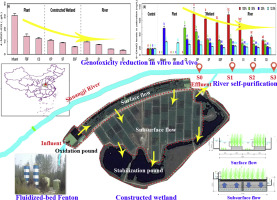当前位置:
X-MOL 学术
›
Sci. Total Environ.
›
论文详情
Our official English website, www.x-mol.net, welcomes your
feedback! (Note: you will need to create a separate account there.)
Feasibility and safety of papermaking wastewater in using as ecological water supplement after advanced treatment by fluidized-bed Fenton coupled with large-scale constructed wetland.
Science of the Total Environment ( IF 8.2 ) Pub Date : 2019-09-10 , DOI: 10.1016/j.scitotenv.2019.134369 Liqun Xing 1 , Ming Kong 2 , Xianchuan Xie 3 , Jie Sun 4 , Dongyang Wei 5 , Aimin Li 3
Science of the Total Environment ( IF 8.2 ) Pub Date : 2019-09-10 , DOI: 10.1016/j.scitotenv.2019.134369 Liqun Xing 1 , Ming Kong 2 , Xianchuan Xie 3 , Jie Sun 4 , Dongyang Wei 5 , Aimin Li 3
Affiliation

|
Reuse of pulp-and-paper industry wastewater as reclaimed water is an effective way to mitigate water resource shortage. In this study, the feasibility and safety of papermaking wastewater for the use as ecological water supplement after the treatment by fluidized-bed Fenton (FBF) coupled with constructed wetland (CW), were investigated from laboratory-scale to large-scale field. The optimum pH, H2O2, H2O2/Fe2+ ratio and hydraulic retention time (HRT) of FBF were 3.5, 0.93 mL/L, 4 and 60 min, respectively, based on reduction of both total organic carbon (TOC) and genotoxicity. Furthermore, the safety of effluent was evaluated using SOS/umu assay and 8-hydroxy-2-deoxyguanosine (8-OHdG) in zebrafish. Results showed FBF followed by CW improved the conventional water quality indicators and reduced the toxicity. Average removal rates of chemical oxygen demand (COD), ammonia nitrogen (NH3-N), total nitrogen (TN), total phosphorus (TP) and colority were 87.3%, 93.59%, 51.73%, 84.75% and 95.86%, respectively. The equivalent concentration of 4-nitroquinoline 1-oxide (4-NQO-EQ) decreased from 30.6 ± 1.6 μg/L in influent to 12.4 ± 1.0 μg/L after treated by FBF, then decreased to 5.9 ± 0.4 μg/L after treated by CW and to 3.2 ± 0.3 μg/L after 12-km downstream self-purification. The chronic survival rates of 21-d zebrafish significantly increased from 0.0% in influent to 58.8 ± 4.0% in effluent of CW and gradually increased to 68.8 ± 2.6% after 12-km downstream self-purification. Similarly, 8-OHdG level in zebrafish decreased from 120.0 ± 19.3 ng/L in effluent of ecological oxidation pond to 94.0 ± 7.5 ng/L in effluent of CW and gradually decreased to 42.0 ± 3.0 ng/L after 12-km downstream self-purification. The study concluded that FBF-CW is an efficient detoxication and water quality improvement technology for papermaking wastewater to be used as an ecological water supplement.
中文翻译:

流化床Fenton结合大规模人工湿地深度处理后造纸废水用作生态补水的可行性和安全性。
纸浆和造纸工业废水作为再生水的再利用是缓解水资源短缺的有效途径。在这项研究中,从实验室规模到大型领域,研究了流化床芬顿(FBF)结合人工湿地(CW)处理造纸废水作为生态水补充剂的可行性和安全性。基于总有机碳(TOC)和遗传毒性的降低,FBF的最佳pH,H2O2,H2O2 / Fe2 +比和水力停留时间(HRT)分别为3.5、0.93 mL / L,4和60分钟。此外,使用SOS / umu分析和斑马鱼中的8-羟基-2-脱氧鸟苷(8-OHdG)评估了废水的安全性。结果表明,BFF和CW改善了常规水质指标并降低了毒性。化学需氧量(COD),氨氮(NH3-N),总氮(TN),总磷(TP)和色度的平均去除率分别为87.3%,93.59%,51.73%,84.75%和95.86%。经FBF处理后,4-硝基喹啉1-氧化物(4-NQO-EQ)的当量浓度从进水的30.6±1.6μg/ L降低至12.4±1.0μg/ L,然后在处理后降至5.9±0.4μg/ L在连续12 km的下游自纯化后,通过CW达到3.2±0.3μg/ L。21天斑马鱼的慢性存活率从进水的0.0%显着提高到CW的出水的58.8±4.0%,并在下游12 km自纯化后逐渐增加到68.8±2.6%。同样,斑马鱼中的8-OHdG水平从生态氧化池的出水量的120.0±19.3 ng / L降低到CW的出水量的94.0±7.5 ng / L,并逐渐降低至42.0±3。下游12 km自纯化后为0 ng / L。研究得出结论,BFF-CW是一种用于造纸废水的生态系统水补充剂,是一种有效的脱毒和水质改善技术。
更新日期:2019-09-11
中文翻译:

流化床Fenton结合大规模人工湿地深度处理后造纸废水用作生态补水的可行性和安全性。
纸浆和造纸工业废水作为再生水的再利用是缓解水资源短缺的有效途径。在这项研究中,从实验室规模到大型领域,研究了流化床芬顿(FBF)结合人工湿地(CW)处理造纸废水作为生态水补充剂的可行性和安全性。基于总有机碳(TOC)和遗传毒性的降低,FBF的最佳pH,H2O2,H2O2 / Fe2 +比和水力停留时间(HRT)分别为3.5、0.93 mL / L,4和60分钟。此外,使用SOS / umu分析和斑马鱼中的8-羟基-2-脱氧鸟苷(8-OHdG)评估了废水的安全性。结果表明,BFF和CW改善了常规水质指标并降低了毒性。化学需氧量(COD),氨氮(NH3-N),总氮(TN),总磷(TP)和色度的平均去除率分别为87.3%,93.59%,51.73%,84.75%和95.86%。经FBF处理后,4-硝基喹啉1-氧化物(4-NQO-EQ)的当量浓度从进水的30.6±1.6μg/ L降低至12.4±1.0μg/ L,然后在处理后降至5.9±0.4μg/ L在连续12 km的下游自纯化后,通过CW达到3.2±0.3μg/ L。21天斑马鱼的慢性存活率从进水的0.0%显着提高到CW的出水的58.8±4.0%,并在下游12 km自纯化后逐渐增加到68.8±2.6%。同样,斑马鱼中的8-OHdG水平从生态氧化池的出水量的120.0±19.3 ng / L降低到CW的出水量的94.0±7.5 ng / L,并逐渐降低至42.0±3。下游12 km自纯化后为0 ng / L。研究得出结论,BFF-CW是一种用于造纸废水的生态系统水补充剂,是一种有效的脱毒和水质改善技术。






























 京公网安备 11010802027423号
京公网安备 11010802027423号